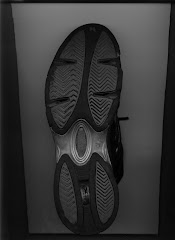If you want to make a fair experiment you are going to have to have limits or variables. If the test is not even then there will be a difference that is not what you are testing. Example: If the one shoe is heavier then the other ones then one will be easier to pull. Not because of its friction, but because of the weight.
There are two different types of variables. The dependant variables and the independent variables. The dependant variables are the measuring variable or the ones that are not chosen. The independent variables are the variables that you choose. In this case the type of shoes was the independent variables and the force was the dependant variables.
Monday, April 28, 2008
Conclusion
We thought that the basketball shoe was going to need the most force for the starting friction but it was the least out of the three shoes. We thought it would need the most force because it was a heavier shoe and the bottom is sort of rough. It turned out that the running shoe needed the most force because it is a running shoe and it is made for a good start. From this project we learned that different shoes are made differently and need a different amount of force.
Friday, April 25, 2008
Analysis
The weight, the speed in which you pull the spring scale, and the surface material. The relationship between weight and speed in which you pull the spring scale is is non-existent. The relationship between the weight and the surface material exists, because the weight cannot be to little or to less. If its to small, secure contact between the shoe and the surface is not reliable. If its to heavy, the shoes sole may deform. If its really heavy, than the surface may deform,too. The relationship between the speed and the surface does not exist. We can improve the experiment by changing weight and the surface material, such as doing it outside compared to doing it on the carpet.
Tuesday, April 22, 2008
The Data
| Sneaker | Type of Sneaker | Starting Friction (N) | Sideways Stopping Friction (N) | Forward Stopping Friction (N) |
| A | Basket Ball | 3.8N | 2.1N | 2.5N |
| A | Basket Ball | 3.2N | 2.5N | 2.3N |
| A | Basket Ball | 3.4N | 2.4N | 2.6N |
| | Average Friction | 3.5N | 2.3N | 2.5N |
| B | All Around | 3.4N | 4N | 3.8N |
| B | All Around | 3.8N | 4.1N | 4N |
| B | All Around | 4N | 4.4N | 3.9N |
| | Average Friction | 3.7N | 4.2N | 3.9N |
| C | Running | 4.1N | 4.2N | 4.7N |
| C | Running | 4N | 4.3N | 4.9N |
| C | Running | 4.1N | 4.2N | 4.8N |
| | Average Friction | 4.1N | 4.2N | 4.8N |
Procedure
To start this experiment, we made a data table to record all the data. To make this a fair experiment, we made all the shoes weigh the same weight. We made all the shoes weigh 500g, but you can change it if necessary. We put weights in the shoes, like 1 yen coins, marbles, and little weights.
Now we are ready to start this experiment. We placed the shoe on a desk and did our experiment, but the surface can be changed. Point being, the surface must be the same for all experiments to make it a fair experiment.We put a paper clip on the back of the shoe to measure the starting friction. We now hooked up a spring scale to the paper clip, and pull at a slow, constant speed. When the shoes starts to move a bit, stop pulling the scale and look at the measurements, and record on the table. We recorded the measurements by Newton(N). You must repeat this three times.
To measure the forward-stopping friction,we attached the paper clip on the front of the sneaker. We did the same procedure for the starting friction.
To measure the sideways-stopping friction, we attached the paper clip on the side of the sneaker this time. We did the same procedure as the starting friction. Do not forget to record the data.
Now we are ready to start this experiment. We placed the shoe on a desk and did our experiment, but the surface can be changed. Point being, the surface must be the same for all experiments to make it a fair experiment.We put a paper clip on the back of the shoe to measure the starting friction. We now hooked up a spring scale to the paper clip, and pull at a slow, constant speed. When the shoes starts to move a bit, stop pulling the scale and look at the measurements, and record on the table. We recorded the measurements by Newton(N). You must repeat this three times.
To measure the forward-stopping friction,we attached the paper clip on the front of the sneaker. We did the same procedure for the starting friction.
To measure the sideways-stopping friction, we attached the paper clip on the side of the sneaker this time. We did the same procedure as the starting friction. Do not forget to record the data.
Sticky Sneakers
We chose three different types of shoes to compare friction. One type of shoe was a basketball shoe. Another was a simple running shoe. And the last one was an all-around shoe.
The purpose of the lab was to find out which type of shoe had the most friction.
The purpose of the lab was to find out which type of shoe had the most friction.
Subscribe to:
Comments (Atom)



